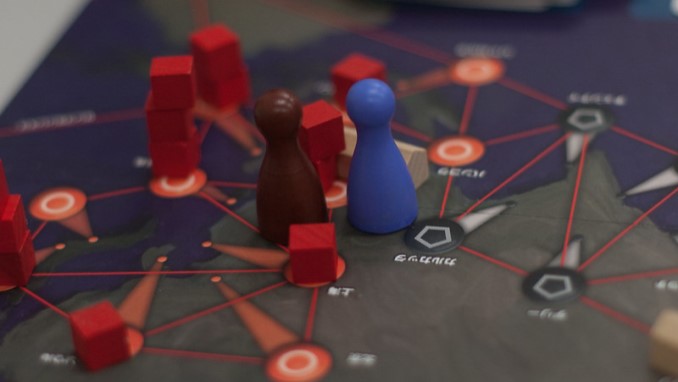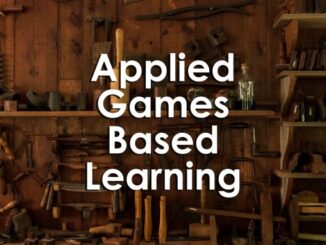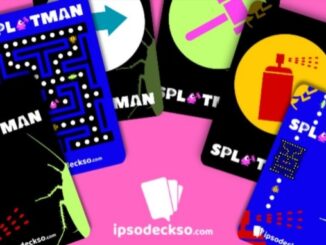
If you read Ludogogy regularly, you will know that I think that learning and fun are exactly the same thing, so you will always be learning when you play games – with the exception that you will cease to learn quite quickly from certain trivial games or those that are based largely on chance. This article however is about the use of games in designed learning sessions, to serve identified learning outcomes.
In the interests of clarity, I am going to use a single, hopefully, fairly well-known and understood, game in my example of learning using a Commercial Off the Shelf (COTS) game. The game is Pandemic.
Pandemic (all versions) is available on Amazon
Pandemic is a turn-based cooperative boardgame in which players undertake different roles, with different capabilities, to attempt to combat a series of viral outbreaks happening globally. It features hand-management and set collection mechanics, trading and a variety of actions that can be taken each turn.
The remainder of this article focuses on some general, and practical, principles for using a COTS game for learning

Pick a game to suit your learning outcomes
Yes, I know we’ve recently experienced a real pandemic, but you wouldn’t chose Pandemic because you want to meet learning outcomes around medicine, research or even living with a pandemic. That is the game’s theme but Pandemic is not a simulation. Simulations are beyond the scope of this article. So that being the case, what on earth is it that COTS games can help learners with?
Like most Euro games, Pandemic is heavy on strategy, and a lot of the stuff that goes with that – strategic planning and execution, working together / siloing. The uncertainty within the game – there are cards which suddenly increase the spread of diseases, can be leveraged for outcomes around living a VUCA world. The cooperative nature of the game allows exploration of team dynamics, where specialist roles fit in into an overall strategy, and organisational structure etc.
When deciding on a suitable game, look beyond (way, way beyond) the game’s theme and reflect on the experiences that people have when playing. Think about those experiences in conceptual rather than specific terms. For example, rather than thinking that Codenames is about guessing words based on clues, think that it is about effective communication. Rather than categorising Age of Empires as a game of medieval conquest, reflect on it as an experience of resource management.
Set up a learning process
Players will learn when playing, but it will be far more effective if you set up a more formal framework in which learning can be consolidated. This will definitely include some time for individual, and maybe team reflection on what happened when they played.
If it is possible, a facilitator or similar should be able to observe play, and collate facilitative questions to draw out learnings from what has happened. During the process of selecting the game and mapping it to desired learning outcomes, it should have been possible to devise themes that you want drawn out by questions, and the actual substance of these can be finalised by a skilled facilitator while observing.
Kolb’s Learning Cycle provides an excellent starting point for creating a learning process. The gameplay provides the concrete experience. Learners then reflect on that, then conceptualise and experiment with what they could do differently next time – or more likely, in a learning setting, how they could apply their insights from play to a non-play context.
This process will help to ‘draw attention to’ the learning that is occurring, which players might have missed noticing because they are ‘just’ playing a game.
In our example game of Pandemic, the ‘win/loss’ dynamic is absolute. All player either win or they all lose. It would be appropriate therefore to allow time for quiet reflection on what happened individually for each player – in their differing roles, and then to invite the players to reflect on how they performed as a team – using the questions devised during observation as prompts if necessary.
Reflection is thinking and organising thoughts, not talking, so make sure you allow time for that to happen before asking them to draw conclusions (conceptualise) – which is what the questioning is for. Ask them what went well, and what didn’t, where the key turning points (either in the teams of viruses’ favour) occurred, or whether their individual or team strategy was successful, and why.
Lead them into experimentation with questions about how they would apply what they have learnt to another round of play. How might they be more agile knowing that an Epidemic card could turn up at any point? Given what they have learned about movement restrictions, how might they optimise the player positions throughout play?

Find real-world relevance in the game
During the facilitation process it is especially important to draw out the real-world relevance of the game experiences. You might want to refer to another learning theory, Andragogy, to reflect on why that is so necessary when creating learning for adults.
You have already identified which learning outcomes are served by Pandemic, but it will be necessary (more for some players than others) to be explicit about how the game experience relates to their real world life or work experience. They are not medical researchers (most probably), but when have they experienced a similar situation? E.g. Your position on the board meant that you were not able to swap the card with another player which would have meant narrow victory instead of narrow defeat – when in your work setting have you been in a situation where a small adjustment would have made a massive difference in consequences? This is the opposite process that you went through when ‘conceptualising’ the game to pick a suitable game for your outcomes. You are taking the conceptual experiences within the game and mapping them back to reality.
Hack the game and modding
One of the most effective ways of finding relevance, of optimising the learning from experimentation and to allow role models to emerge, is to invite players to ‘hack’ the game. Playing a game is a much more participatory way of learning than say a lecture or reading, but players are still to some extent consuming an experience which has been made for them by someone else. Astute players/learners will have got to grips with the mechanisms and systemic nature of the game and can be encouraged to think about how they would change those to achieve a better outcome (or even to make it more challenging if they won).
They might for example, come up with a new role, with different capabilities, or change what a specific playing component triggers, or create a new move in the game.
The hacking of the game can, of course, occur before the learners even get to it. Games are systems of rules and mechanics, usually dressed in a theme. Any of these elements can be tweaked, with differing degrees of difficulty, to customise the game to your learning needs.
The theme is usually the easiest aspect to amend. You can make the experience of play more relevant by doing this. For example, one of the central mechanics in Pandemic is the proliferation of coloured cubes in various locations on the board (map). Thematically this represents outbreak of one of four viruses. Without changing the mechanic in any other way this could be re-themed to represent industrial unrest or even, more cheerfully, popularity of your product/idea. Instead of a map your board could represent past, present and future timescales – and so on.
Changing the rules
Rules are the next easiest to modify, although this does mean that you are changing the system of the game, rather than just the clothes it wears, so more care is needed to protect the integrity of the gameplay and experience. Adding ‘house rules’ can alter the experience of a game, to make it easier or harder, or just to add a different characteristic to make the experience more fun or relevant. In Pandemic, you can take up to four actions per turn, so simply changing the permitted number of actions could drastically alter the nature of the game.
Mechanics can be altered / added / removed too, but this probably the most complex option, with the greatest potential to alter the game experience. For example, Pandemic features point to point movement on a map, and where you are on the map further influence character interaction and capabilities. Removal of the movement requirement would make interaction easier, placing further restriction on movement options would put further obstacles in player’s paths. Adding a random element could make the world a whole lot more VUCA – the possibilities are almost endless.

Modding is a term that is usually applied to COTS video games (although the same principles of amending to learning purposes applies to tabletop games). Moddable (video) games come with special editors. Doom was one of the first to do this, allowing players to create their own playable levels. Popular modded/ moddable games today include Fallout: Las Vegas and Mech Warrior, and there are thriving modding communities.
Starting to view games differently
Once you have used games in this way a few times, and particularly if you have indulged in modding, you will start to look differently at the games in your collection, and those you are considering adding to it. Specific types of rules and mechanics will become associated with particular learning outcomes. You will categorise game by the ease with which they can be modded. You will start to recognise games that are different ‘versions’ of other games. You will find yourself creating whole new ‘learning genres’ in your head.
Enjoy!
- James Bore – The Ransomeware Game - 13th February 2024
- Ipsodeckso – Risky Business - 23rd January 2024
- Review – Luma World Games - 15th December 2023





Fantastic article thanks Sarah. This has made me think about how I could bring a game idea I had to life much easier.
Love the idea of hacking the game!
Keep me up to date with how that goes, Cat!
Great instructional and insightful read, Sarah. Another great aspect and real-world parallel of allowing players to make their own rules/mods to a game is the leadership model for allowing team-members to create a fluid and adaptable workplace by encouraging new thinking. This also opens the door to servant leadership model training through exposing the benefits of facilitating change through management, but from a ground-up approach where some of the most actionable and efficient ideas for improvement can come from.